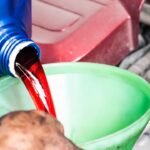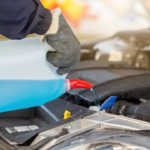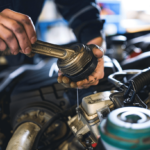Summer is here, and that means it’s time to start thinking about your car’s maintenance needs. Keeping up with car maintenance can be a hassle, but it’s essential to ensure that your vehicle runs smoothly during the hot summer months. Neglecting your car’s upkeep can lead to costly repairs down the road, as well as decreased performance and fuel efficiency.
Table of Contents
The Importance of Summer Car Maintenance
Summer weather can wreak havoc on your car if you’re not careful. High temperatures and intense sunlight can cause all sorts of problems, from worn-out tires to overheating engines.
Regular maintenance can help prevent these issues and keep your vehicle running smoothly all summer long. One of the most critical aspects of summer car maintenance is keeping an eye on tire pressure and tread depth.
Hot pavement can cause excessive wear on tires, which makes regular inspections particularly important during the summer months. Proper tire alignment is also crucial for optimal performance and safety when driving.
The Benefits of Staying Up-to-Date on Car Maintenance
Staying up-to-date on your car’s maintenance needs offers several benefits aside from avoiding costly repairs in the future. Maintaining regular upkeep helps increase fuel efficiency, which saves money at the gas pump.
It also helps extend the life of your vehicle by ensuring that all components are working correctly. Moreover, properly maintained vehicles are safer for you and everyone on the road around you.
Regularly checking brakes, belts, hoses, fluids, batteries ensures you won’t be stuck with faulty components when you’re out driving or travelling long distances this summer. Keeping up-to-date with recommended oil changes will keep everything lubricated as well ensuring engine functionality even after a few years’ use.
Regularly maintaining your vehicle is essential to ensure optimal performance this summer season while avoiding unexpected expenses from damage caused by wear and tear. The next section will delve into specifics about tire maintenance, a task that is often overlooked but can significantly affect the longevity of your vehicle.
Check Your Tires: Keep Your Car Rolling
Your car’s tires are the only part of the vehicle that touches the road, which makes them crucial for your safety and the longevity of your car’s other components. The right tire pressure and tread depth are necessary to maintain a good grip on the road, while proper alignment ensures even wear across all four tires.
Tire Pressure and Tread Depth
Checking your tire pressure is easy and important. When your tires are underinflated, they can cause poor gas mileage, uneven wear, and even a potential blowout. You can find the recommended tire pressure in your owner’s manual or on a sticker inside the door jamb.
Using a tire gauge, remove the valve cap from each of your four tires and press down on it until some air escapes. Then attach the gauge to measure how much pressure is in each tire.
Tread depth is another critical aspect of tire maintenance. A good rule of thumb is to have at least 1/8 inch (3 mm) of tread left on each tire for safe driving conditions.
Use a penny to check whether you need new tires – place it with Lincoln’s head facing down in one of the grooves between treads. If you can see all of Lincoln’s head, it’s time to get new tires.
Proper Tire Alignment
When you hit potholes or curbs or have been in an accident, it can knock your car’s wheels out of alignment – this should be corrected as soon as possible because uneven wear will occur if you don’t adjust it later on! It may also cause excessive vibration or shaking at high speeds.
To check if your wheels are misaligned, look for signs such as uneven tread wear or a crooked steering wheel when driving straight ahead. If needed consult with professionals who have state-of-the-art diagnostic equipment to make sure your wheels are aligned correctly.
Keep Your Engine Cool
Summer heat can put extreme stress on your car’s engine, which is why it is important to keep it cool. The last thing you want is to be stuck on the side of the road with an overheating engine.
To avoid this, check your coolant levels regularly and make sure the quality of the coolant is good. If you notice any leaks, have them fixed immediately to prevent further damage.
In addition to checking coolant levels, inspecting hoses and belts for wear and tear is also crucial. Over time, hoses and belts can become brittle and crack due to heat exposure.
This can lead to leaks and breakage, potentially causing major engine issues. Make sure all hoses are securely fastened and free from cracks or other damage.
Check all belts for fraying or cracking as well as proper tension. A loose belt can cause a lot of problems down the line if not corrected in a timely manner.
Check Coolant Levels And Quality
Checking your coolant levels should be a regular part of your summer car maintenance routine. It’s important to ensure that there is enough fluid in the system to keep your engine cool while driving in hot temperatures. When checking your coolant levels, make sure the engine is cold before removing the radiator cap or overflow tank cap (if equipped).
If needed, add more fluid until it reaches the proper level but never overfill. The quality of your coolant also matters.
Over time, old coolant can become contaminated with rust particles or other debris that can clog up your cooling system resulting in poor performance or even damage to sensitive parts like water pumps or radiators. Consider flushing out old antifreeze with fresh new one at least once every two years.
Inspect Hoses And Belts For Wear And Tear
Another important aspect of keeping your engine cool involves inspecting hoses and belts for wear and tear. Hoses that are cracked or leaking can cause coolant to escape, leading to overheating and engine damage. Belts that are frayed or loose can break or slip off, causing the water pump to stop working which will cause an overheated engine too.
Don’t forget the serpentine belt too, as it drives most of our car’s accessories including the water pump and alternator. To ensure your hoses and belts are in good condition, perform a visual inspection for cracks or wear marks.
If you notice any problems, replace them immediately before they cause further issues down the line. Regularly checking your hoses and belts can save a lot of money on repairs later on as well as keep your engine running smoothly in hot weather conditions.
Maintain Your Battery
Check battery terminals for corrosion
The battery is the heart of your car’s electrical system, and during summer months, it works overtime to power the air conditioning and other systems. Corrosion on battery terminals is a common problem that can prevent your car from starting or cause it to stall while driving. Regularly checking and cleaning the terminals can help prevent this issue.
To check for corrosion, first, turn off the engine and open the hood of your car. Locate the battery – it is usually a large rectangular box with a red or black cable attached at either end.
Look at the ends of each cable where they connect to the battery terminals. If you see white or greenish-blue buildup on either end, that’s corrosion.
You can clean this off using a wire brush or a mixture of baking soda and water. Be sure to wear gloves and eye protection when doing this as battery acid can be dangerous.
Test Battery Strength
Another important aspect of maintaining your car’s battery is testing its strength regularly – ideally every few months or before long road trips. You don’t want to be stranded with a dead battery in scorching summer heat!
There are several ways to test your car’s battery strength: – Use a multimeter: This device measures voltage levels in electrical systems, including batteries.
– Have it tested at an auto parts store: Many auto parts stores offer free testing services. – Observe any warning signs: If you notice slow cranking when starting your car, dimming headlights, or other electrical issues, these may be signs that your battery is weak.
If you find that your car’s battery is weak or not holding a charge well, it may be time to replace it. A quality replacement will ensure that all of your electrical systems are functioning properly during summer months and beyond!
Clean Your Car’s Exterior
Wash Your Car Regularly
Now that the summer is here, it’s important to take extra care in cleaning your car’s exterior. Regularly washing your car can help remove dirt, salt, and other debris that can cause damage to your car’s paint job.
Additionally, keeping a clean car looks great and makes it more enjoyable to drive. When washing your car, be sure to use a high-quality soap specifically designed for vehicles.
Using dish soap or other household cleaners can strip away the protective wax on your vehicle, leaving it vulnerable to scratches and sun damage. After thoroughly washing and rinsing your vehicle, dry it off with a soft towel or chamois cloth to prevent water spots.
Wax to Protect Paint from Sun Damage
Not only does regular washing keep your car looking great, but adding a layer of wax can also protect the paint from damaging UV rays during summer months. Waxing creates a barrier between the sun’s harmful rays and your vehicle’s exterior surface.
There are many different types of wax available on the market today, including spray-on waxes and paste waxes. Look for products that contain UV protection ingredients such as Titanium Dioxide or Zinc Oxide for added protection against sun damage.
It is recommended to wax your car at least twice per year, with special emphasis on summertime due to increased exposure to sun rays. Keeping up with regular cleaning and maintenance of your vehicle’s exterior during these hot summer months will not only extend its life but also make it look newer for longer periods of time!
Don’t Forget the Interior
Clean air filters
When it comes to keeping your car running smoothly and efficiently, don’t neglect the air filters in your car’s engine. Your vehicle’s air filter is responsible for preventing dirt, debris, and other contaminants from entering your engine. Over time, these particles can build up in the filter and reduce its effectiveness.
A dirty air filter can lead to poor fuel economy, reduced engine performance, and even damage to your engine. To keep your car’s air filter clean and functioning properly during the summer months, it’s important to have it checked regularly by a professional mechanic.
In addition to visually inspecting the filter for signs of wear or damage, they will also be able to clean or replace it as needed. Another DIY option is to check your car’s owner manual for instructions on how you can remove and clean the air filter yourself.
Check air conditioning system
Summertime heat can be brutal, especially when you’re stuck in traffic or driving long distances. That’s why having a functioning air conditioning system is essential during the summer months. To keep your AC working at its best all season long, you’ll need to take a few steps.
Firstly, make sure that there are no leaks in your AC system by conducting an AC pressure test with a professional mechanic. It’s also essential that you replace any damaged or worn out belts as this can cause problems with cooling systems’ operation.
Additionally, regularly checking that there is enough refrigerant gas ensures optimal cooling performance throughout summer! Regular maintenance will help ensure that you don’t spend any more time than necessary feeling hot and uncomfortable behind the wheel of your car this summer!
Additional Tips for Summer Driving
Keep an Emergency Kit in Your Car
Summer driving can be unpredictable, so it’s important to always be prepared. One way to do this is by keeping an emergency kit in your car. This kit should include items such as a flashlight, extra batteries, a first aid kit, water bottles, non-perishable snacks and blankets.
Additionally, keep a phone charger and a map in your car just in case you lose signal or GPS. Another essential item is jumper cables because dead batteries can happen to anyone at any time.
Also make sure you have a spare tire with the necessary tools to change it if needed. You never know when unexpected car troubles might occur and having an emergency kit can help ensure that you are ready for anything.
Plan Ahead for Long Road Trips
If you’re planning on taking a long road trip this summer, it’s important to plan ahead before hitting the road. First and foremost, make sure your vehicle is up-to-date on its summer maintenance needs before leaving home. You don’t want any unexpected issues arising while on the road.
It’s also important to plan out your route ahead of time so that you know where you’re going and what places along the way may be worth stopping at for food or rest breaks. Plan regular stops during long drives to stretch your legs and avoid fatigue-related accidents.
Make sure that everyone in the vehicle is properly buckled up before setting off on your journey. Remember that safety should always come first when driving long distances during summer months when roads can become more crowded with vacationers and tourists alike.
Conclusion
Driving during the summer can be a fun and exciting experience, especially if you keep your car in top shape. Whether you’re planning a long road trip or just cruising around town, it’s important to stay up-to-date on your car’s summer maintenance needs. In this article, we’ve covered several key areas that you should focus on when maintaining your car during the hottest months of the year.
First and foremost, make sure to check your tires regularly. This means checking tire pressure, tread depth, and alignment on a monthly basis.
Additionally, be sure to keep your engine cool by checking coolant levels and inspecting hoses and belts for wear and tear. Your battery is also an important component of your car that requires regular maintenance – make sure to check battery terminals for corrosion and test battery strength as needed.
Don’t forget about the exterior of your car! Regular washing will help protect against sun damage, while waxing can help maintain paint quality over time.
And last but not least, don’t neglect the interior of your car! Check air filters and make sure the air conditioning system is functioning properly.
Taking care of your car during the summer months is essential for both safety and performance reasons. By following these simple tips, you’ll be well-equipped to handle any driving conditions that come your way this season – so get out there and enjoy the ride!






